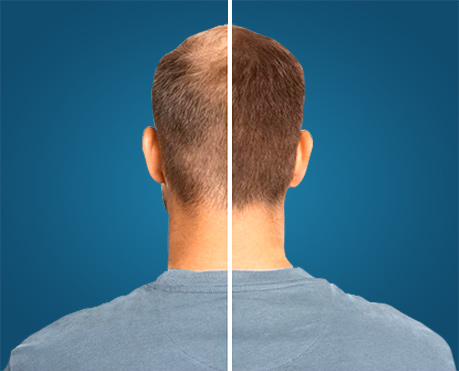Top 10 Dermatologist in Chennai: For Skin and Hair Problems
Top 10 Dermatologist in Chennai: For Skin and Hair Problems
Discover Top 10 Dermatologist in Chennai for top-notch skin care and treatments. Get expert advice and quality service.
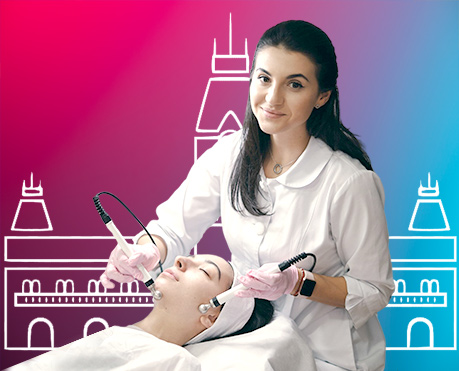
In a bustling city like Chennai, it is important to find a qualified and consult a dermatologist who will give you a healthy glowing skin. Whether you are dealing with chronic skin conditions, want to achieve a healthy skin tone or just want regular skin care, Chennai welcomes the best dermatologist in India.
Here we are the top 10 dermatologists in Chennai known for their expertise, patient care and innovative treatments.
Top 10 Dermatologist in Chennai
1. Dr. R. Amin Hanan
Expertise and Background
Dr. R. Amin Hanan is a renowned dermatologist and trichologist with a focus on skin hair and nail disorders. Founder of Dr.Hanan Dermatology Speciality Clinic is best skin and hair clinic in chennai
Services Offered
- Hair Loss Treatments: Innovative solutions for hair loss and baldness.
- Skin Rejuvenation: Treatments to restore skin vitality.
- Psoriasis Management: Effective therapies for psoriasis.
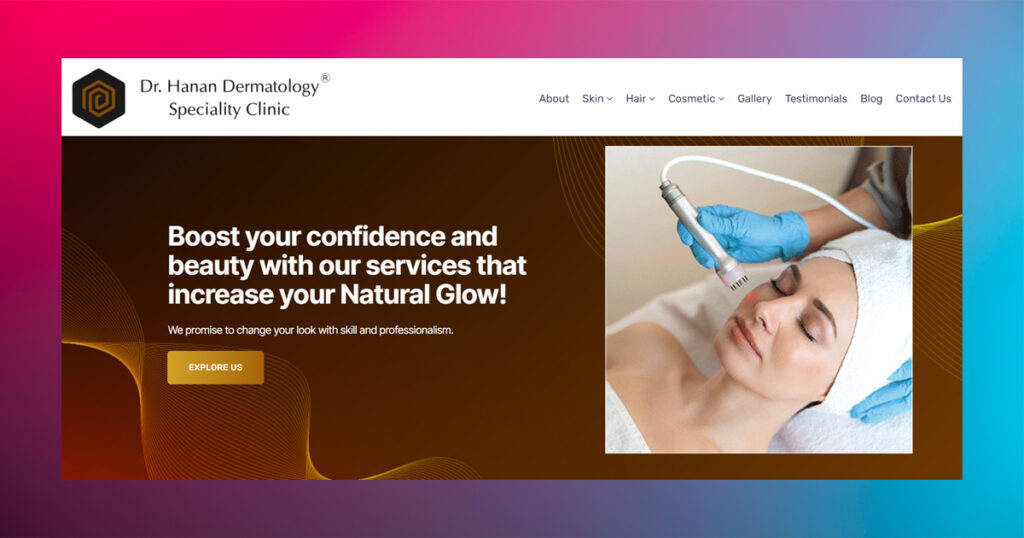
Patient Care
Dr.Hanan patients value his expert care and personalized treatment plans.
2. Dr. S. Murugusundram
Expertise and Background
Dr. S. Murugusundram, the founder of the Chennai Skin Foundation and Yesudian Research Institute, has over two decades of experience in dermatology. He is widely recognized for his specialization in hair and skin treatments.He is one of the best skin doctor in chennai.
Services Offered
- Hair Transplantation: Utilizing advanced techniques for natural-looking results.
- Vitiligo Treatment: Comprehensive care for pigmentation disorders.
- Laser Treatment: State-of-the-art laser therapy for various skin conditions.
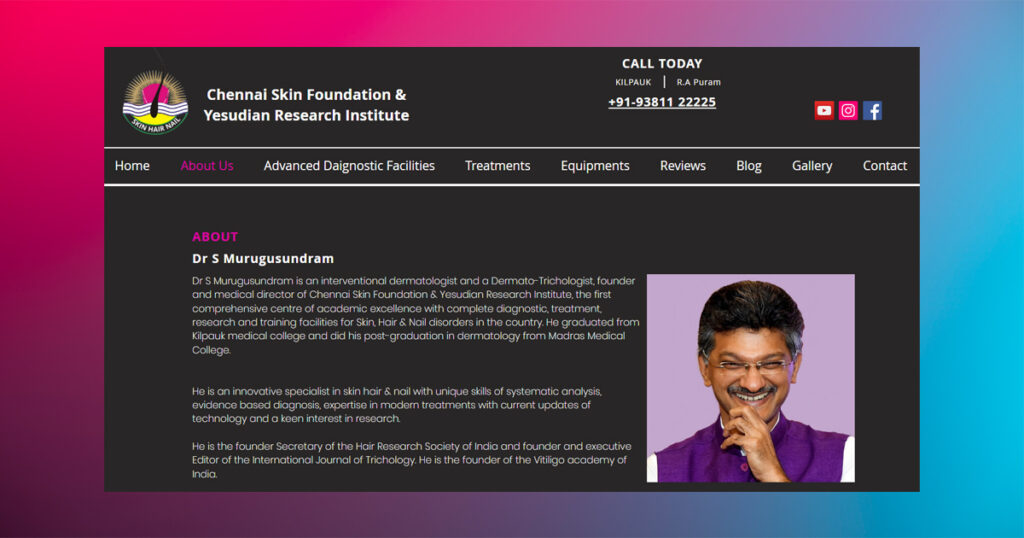
Patient Care
Dr. Murugusundram is praised for his patient-centric approach, ensuring personalized and effective treatment plans.
3. Dr. Maya Vedamurthy
Expertise and Background
Dr. Maya Vedamurthy, director of RSV Skin Clinic and senior consultant at Apollo Hospital, Chennai, has over 30 years of experience. She excels in clinical dermatology, cosmetic dermatology, and dermatologic surgery. Dr maya is the best skin specialist in chennai.
Services Offered
- Acne Treatment: Effective management of acne and acne scars.
- Dermatologic Surgery: Procedures for skin cancers and cysts.
- Anti-Aging Treatments: Non-surgical treatments to reduce signs of anti aging.
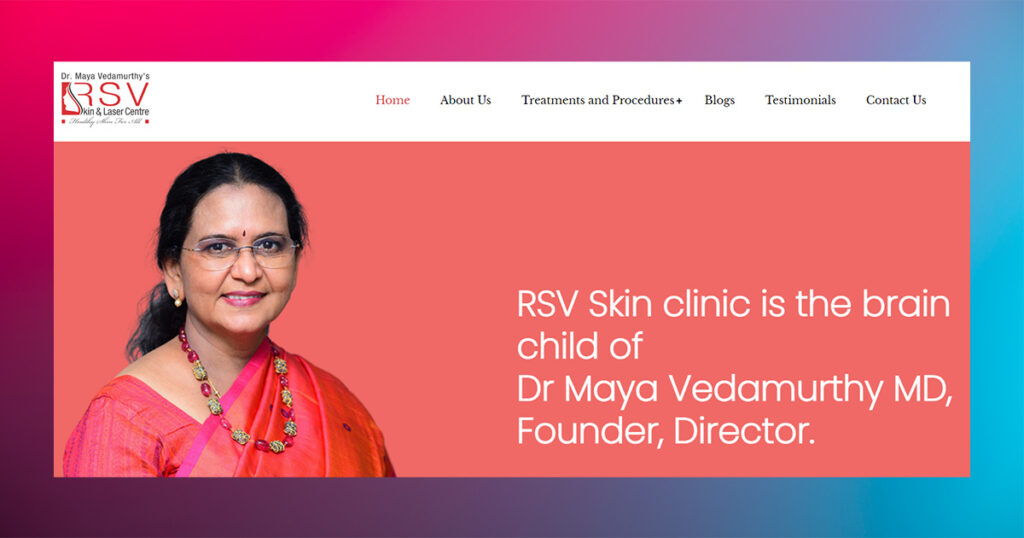
Patient Care
Dr. Vedamurthy’s compassionate care and thorough treatments are highly appreciated by her patients.
4. Dr. Sasikumar Muthu
Expertise and Background
Dr. Sasikumar Muthu, founder of Pearl Skin and Hair Clinic, is known for his expertise in both medical and cosmetic. He is the best dermatologist in chennai. His clinic offers high standards of care with cutting-edge treatments.
Services Offered
- Psoriasis Treatment: Innovative therapies for managing psoriasis.
- Hair Loss Treatments: Comprehensive solutions for hair fall and baldness.
- Skin Rejuvenation: Advanced treatments for skin revitalization.
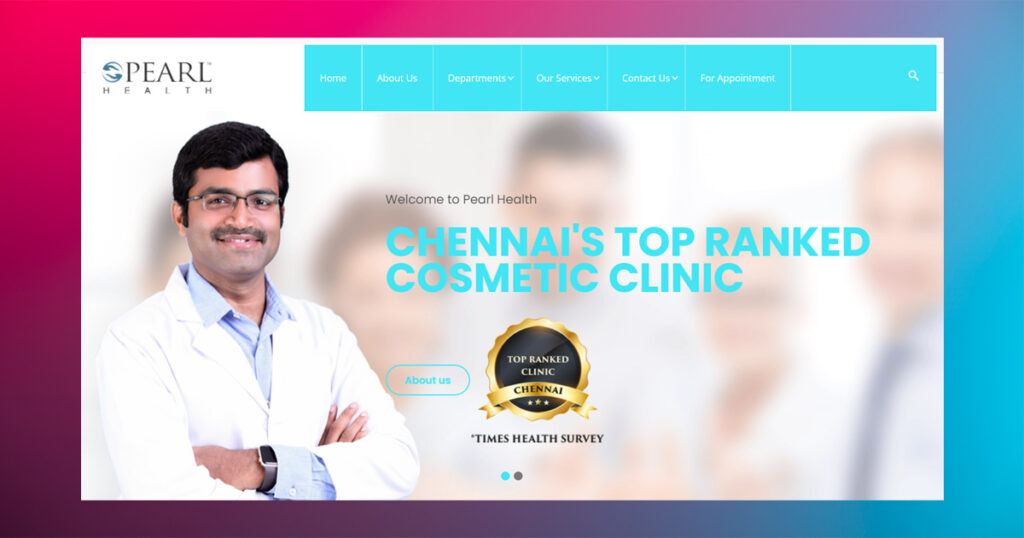
Patient Care
Dr. Sasikumar Muthu detailed consultations and effective treatment plans set him apart.
5. Dr. Karthik Gopal
Expertise and Background
Dr. Karthik Gopal, practicing at Apollo Hospitals, Chennai, has significant experience in treating complex skin disorders and performing aesthetic procedures.
Services Offered
- Eczema and Dermatitis: Specialized treatments for inflammatory skin conditions.
- Laser Hair Removal: Safe and effective hair removal procedures.
- Chemical Peels: Customized peels for various skin concerns.
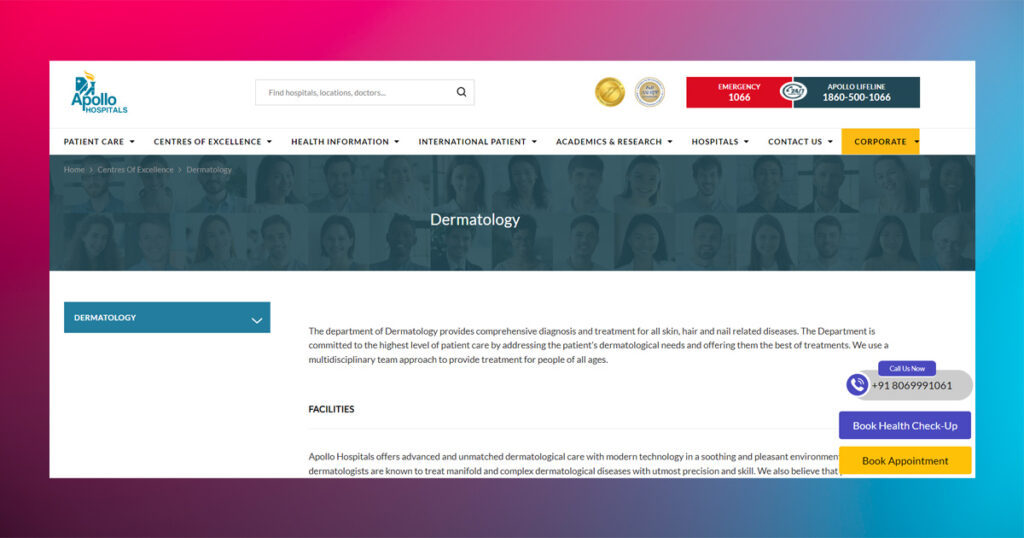
Patient Care
Dr. Gopal is known for his personalized and attentive approach to patient care.
6. Dr. Renita Rajan
Expertise and Background
Dr. Renita Rajan, chief consultant at Render Skin and Hair, is an expert in aesthetic dermatology. dr renita rajan is known for her innovative approach to skin and hair care.
Services Offered
- Pigmentation Treatment: Advanced solutions for hyperpigmentation and melasma.
- Botox and Fillers: Non-surgical treatments for wrinkle reduction and facial contouring.
- Dermatopathology: Accurate diagnose and treat skin diseases through microscopic examination.
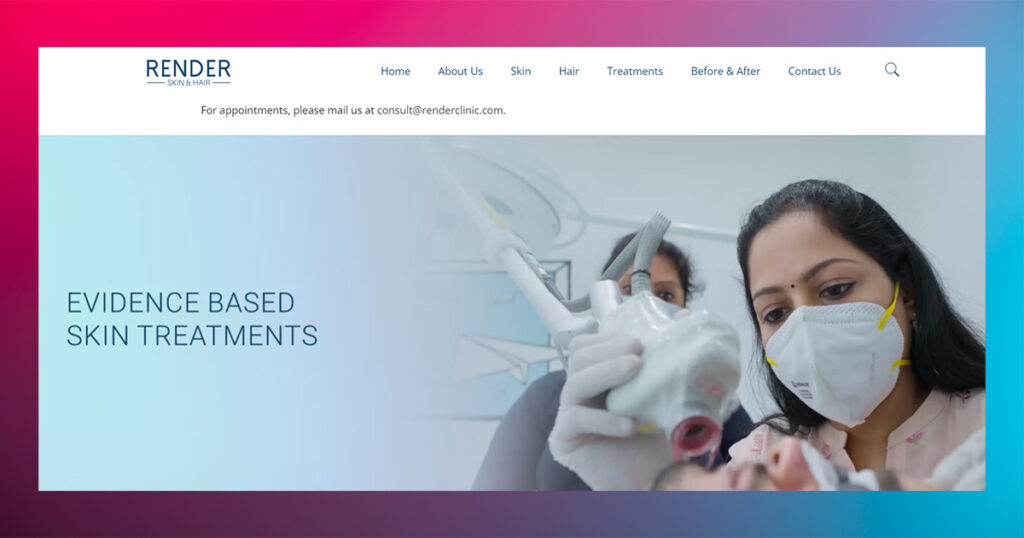
Patient Care
Dr. Rajan’s meticulous care and serene clinic environment are highly valued by her patients. She is the top skin doctor in chennai
7. Dr. A. Ariganesh Chandrasegaran
Expertise and Background
Dr. A. Ariganesh Chandrasegaran, founder of DermaClinix, is known for his expertise in hair transplantation and cosmetic dermatology.
Services Offered
- Hair Transplantation: Cutting-edge techniques for hair restoration.
- Acne Scar Treatment: Advanced treatments for reducing acne scars.
- Laser Treatment: Effective solutions for various skin issues.
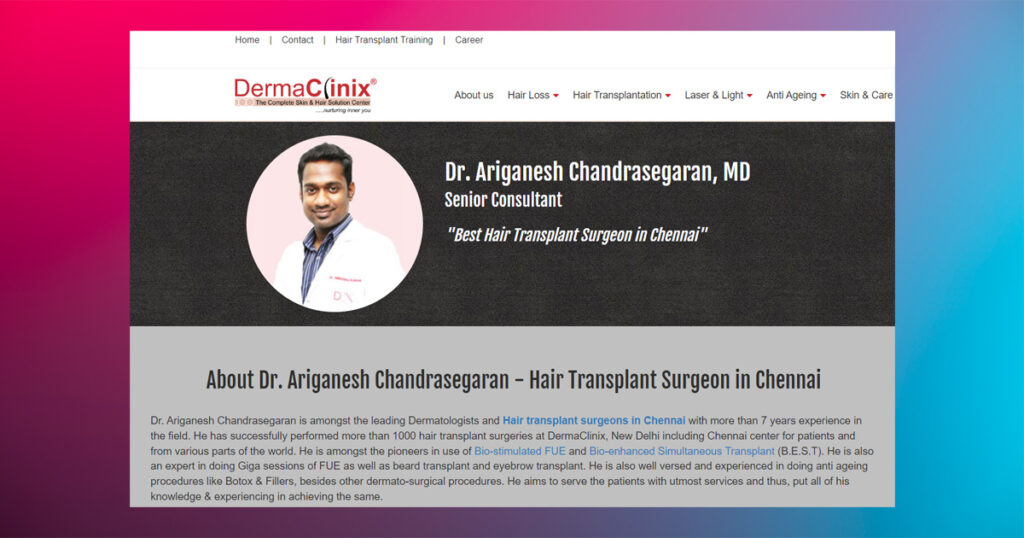
Patient Care
Dr. Ariganesh’s patient-focused approach ensures customized care and excellent results.
8. Dr. Nirmala Subramanian
Expertise and Background
Dr. Nirmala Subramanian is a senior consultant cosmetic dermatologist with extensive experience in clinical and cosmetic dermatology.
Services Offered
- Psoriasis and Eczema: Specialized treatments for chronic skin conditions.
- Anti-Aging Solutions: Non-invasive treatments for youthful skin.
- Laser Hair Removal: Advanced techniques for permanent hair reduction.
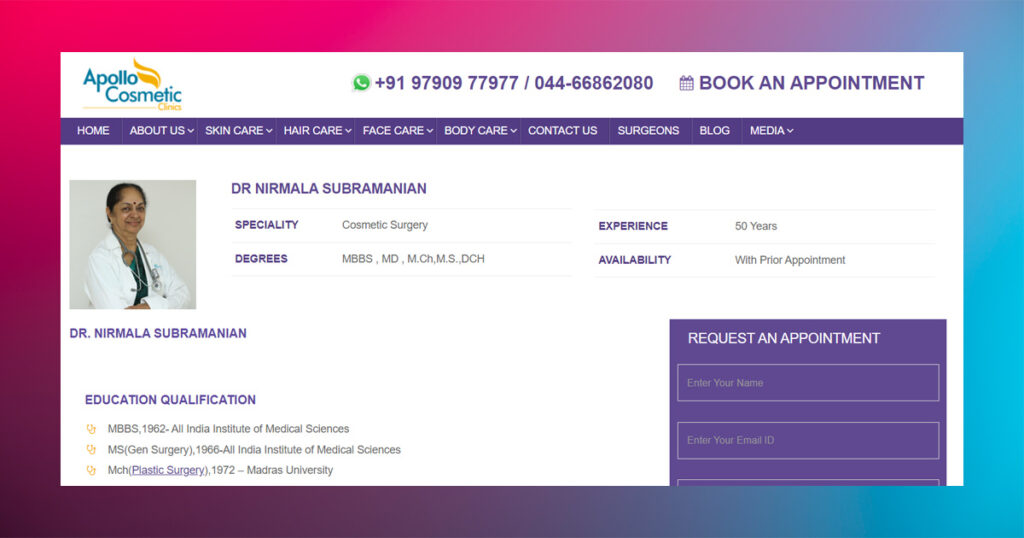
Patient Care
Dr. Subramanian is known for her empathetic and effective treatment strategies.
9. Dr. R. Krishnamoorthy
Expertise and Background
Dr. R. Krishnamoorthy, join director & senior consultant at SIMS, has vast experience in treating various skin disorders and performing dermatologic procedures.
Services Offered
- Vitiligo Surgery: Advanced surgical treatments for vitiligo.
- Skin Allergy Treatment: Effective management of allergic skin conditions.
- Cosmetic Procedures: Non-surgical treatments for skin enhancement.
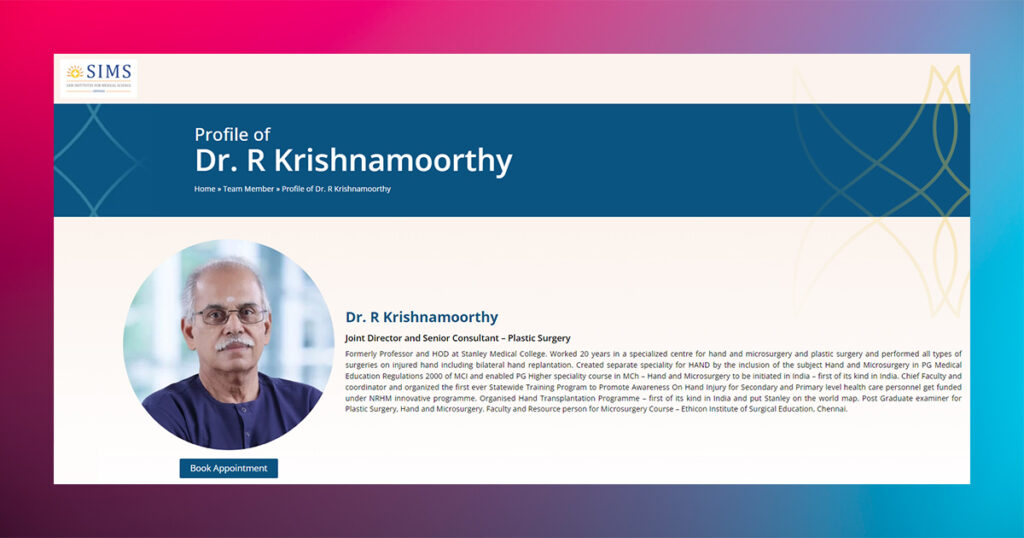
Patient Care
Dr. Krishnamoorthy’s patients appreciate his detailed consultations and effective treatments.
10. Dr. G. Ravichandran
Expertise and Background
Dr. G. Ravichandran is a seasoned dermatologist with a focus on clinical and aesthetic dermatology. He practices at Apollo Hospital.
Services Offered
- Acne Management: Comprehensive treatments for acne and skin related issues.
- Laser Resurfacing: Advanced laser treatments for skin rejuvenation.
- Scar Revision: Effective solutions for reducing the appearance of scars.
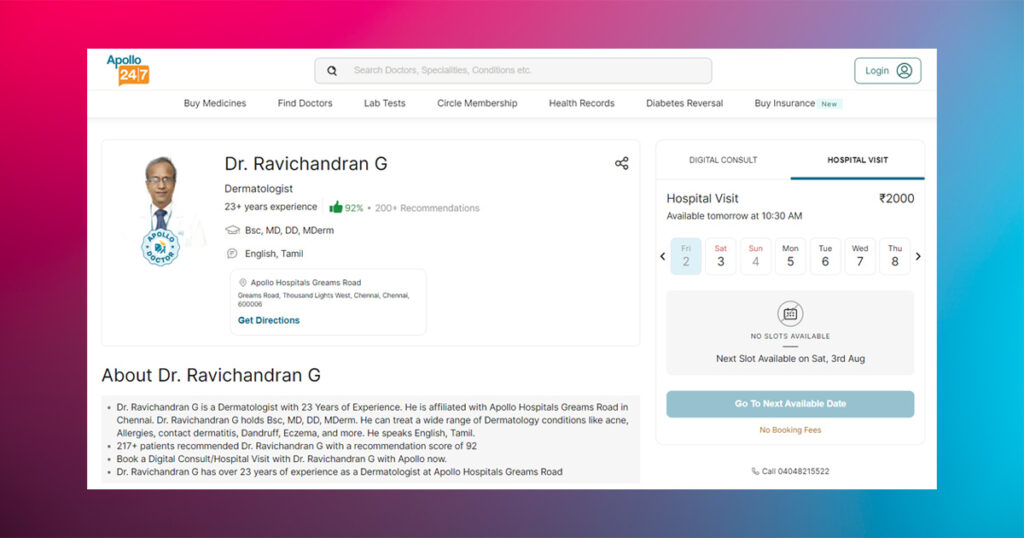
Patient Care
Dr. G. Ravichandran is praised for his thorough and patient-centered approach.
Conclusion
The dermatologists listed above are the top dermatologists in Chennai. They have a lot of experience and work at well-known healthcare places.
If you need help with your skin, consider seeing Dr. Hanan is the best female dermatologist in chennai. She offers free advice on skin care and listens to patients about their skin problems.
Visit Our Dr.Hanan Dermatology Clinic located on omr road, padur, Chennai – 603103.
FAQ’s
They specialize in a variety of treatments including acne management, eczema treatment, psoriasis care, hair loss solutions, skin allergy treatment, pigmentation correction, and cosmetic procedures like chemical peels, laser therapy, and Botox injections.
Yes, many top dermatologists in Chennai offer online consultations through their websites or telemedicine platforms, making it convenient for patients who cannot visit the clinic in person.
Appointments can usually be booked online through the dermatologist's official website, by calling the clinic directly, or via healthcare platforms like Practo and Lybrate.
Table of Contents
How to Use Dermaroller for Hair: Tips, Techniques and Benefits
How to Use Dermaroller for Hair: Tips, Techniques and Benefits
Learn how to use dermaroller for hair growth effectively. Explore types, techniques, benefits, and expert tips for your hair health.

Derma rollers are a popular tool you can use at home as an alternative to microneedling, which is usually done by professionals. It is used on the scalp for hair growth.
Hair loss is a widespread issue, affecting two-thirds of men over the age of 35 years. But it’s not just a male problem—about 40 percent of people with hair loss are women.
While there are many treatments for hair loss, they can be expensive and often require a visit to a specialist. Derma rollers offer an affordable, at-home option that focuses people on the potential benefits of promoting hair growth.
In this blog we will explain how to use a derma roller for your hair. We’ll give you tips, step-by-step instructions, and show you how this works best.
What is a derma roller?
A Derma roller is a handheld device with tiny needles that allows microscopic portions of the skin. These small incisions stimulate the body’s natural healing processes and encourage collagen production, which can help regrow hair when used on the scalp.
According to the FDA, derma rollers are special tools that need to be approved by them. Even though you can buy and use them at home now, it’s safest to use a derma roller with the help of a dermatologist.
Importance of derma rollers for hair growth
Using a derma roller on the scalp can increased blood flow, increase nutrient absorption and stimulate hair growth follicles. Understanding its importance can help those struggling with hair loss or hair loss find potentially effective treatments.
How to Use Dermaroller for Hair?
The skin roller works by making small cuts in the skin with its tiny needles. This process, called microneedling, stimulates the body’s natural healing response.
Minor injuries produce collagen and elastin, which are important proteins that help keep skin firm and firm.
Consequently, this method can help reduce the appearance of fine lines, wrinkles, pimples and smooth the appearance of the skin.
Types and Categories of Derma Roller
Types of Derma Rollers
1. Micro Needling Derma Rollers: Typically used for sensitive areas and less invasive treatments.
2. Titanium Derma Rollers: Known for their durability and effectiveness in penetrating the skin.
3. Stainless Steel Derma Rollers: Common for their balance between efficacy and cost.

Needle Sizes and Their Uses
1. 0.2mm: Primarily used for enhancing topical hair product absorption.
2. 0.5mm: Ideal for stimulating hair growth and treating mild hair thinning.
3. 1.0mm: Used for more significant hair restoration efforts and improving scalp texture.
4. 1.5mm: Suitable for severe hair loss and deep scar treatment.
Pros using Derma Roller
1. Improved skin tone
One of the main advantages of using a derma roller is its ability to keep the skin looking smooth and smooth. Regular use of the product aids in collagen production, resulting in an even skin tone. It is beneficial for individuals who deal with uneven skin tone, large pores and fine lines.
2. Reduction of fine lines and wrinkles
A good massage with a fine scrub can reduce fine lines and wrinkles. As skin heals from micro-trauma, it becomes stronger and more resilient. This procedure helps to smooth fine lines and reduce deep wrinkles, helping to give you a youthful appearance.
3. Diminished Acne Scars
For those struggling with acne, a skin roller can be a game changer. The microneedling technique encourages skin repair and regeneration, and can help fade scarring and improve overall skin tone. This treatment is especially effective for roll out drying acne scars.
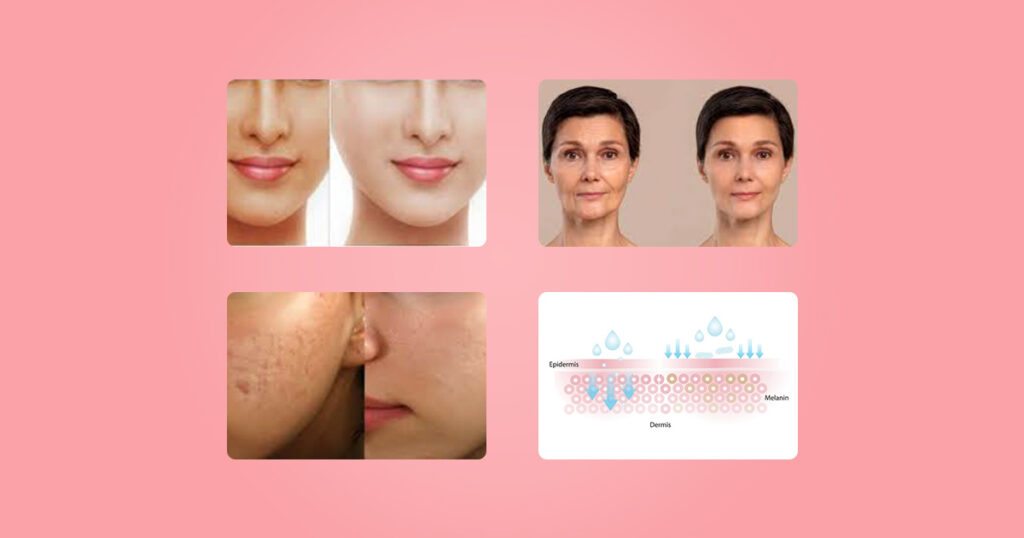
4. Enhanced Absorption of Skincare Products
Microneedling creates microchannels in the skin, allowing for better absorption of topically applied skin care products. Applying a serum or cream after using a derma roller can be more effective as these products penetrate deeper into the skin. This increased absorption can increase the benefits of your skin care routine.
5. Non-invasive methods
Unlike surgery, microneedling with a skin roller is a noninvasive procedure. It can be done at home or professionally, providing a cheaper and less intimidating option for those looking to improve their skin.
Cons of using a derma roller
1. Potential for skin irritation
While tanning needles are generally safe, there is a risk of skin irritation, especially if the needle is not used properly. Overuse or improper use can cause redness, swelling and sensitivity. It’s important to follow the instructions carefully and avoid rubbing on irritated or broken skin.
2. Risk of infection
If skin is not cleaned properly, it can be a breeding ground for bacteria. This can increase the risk of developing skin infections or aggravate existing skin infections. It is important to clean the machine before and after each use to prevent any potential problems.
3. Temporary discomfort
Microneedling can cause some discomfort during surgery. Although the sensation is usually tolerable, individuals with sensitive skin can have more trouble. Using anesthesia prior to surgery can help reduce this discomfort.

4. Results may vary
The effectiveness of a derma roller can vary from person to person. Growth factors such as skin tone, severity of skin issues and regular use can affect the optimal results. Setting realistic expectations and patience are also important, as it may take several iterations to see significant improvement.
5. Not suitable for all skin types
Individuals with eczema, psoriasis, active acne or a skin disorder should avoid using skin rollers. The procedure can make these conditions worse or worse. Those with sensitive or problematic skin should consult a dermatologist before microneedling.
Finally Consult a best dermatologist in chennai before Using Derma Roller
Why Consult a Doctor?
Personal Health Conditions: Everyone’s skin and scalp are different, and existing health conditions can affect how well you respond to a derma roller.
Conditions like eczema, psoriasis, or severe acne might be aggravated by using a derma roller. A doctor can provide personalized advice based on your health history.
Correct Usage: Your doctor can recommend the right needle length size and frequency of use for your specific needs. This helps avoid potential side effects and ensures you’re using the derma roller correctly.
Avoiding Risks: Although derma rolling is generally safe, there are risks like infections or increased sensitivity.
Consulting with a healthcare professional helps you understand how to minimize these risks and ensure your skin or scalp is healthy enough for the treatment.
Tailored Aftercare: Proper aftercare is crucial for achieving the best results and avoiding complications. Your doctor can give you tailored advice on how to care for your skin or scalp after using the derma roller.
Overall Treatment Plan: If you’re using a derma roller as part of a broader treatment for hair loss or skin issues,
Our Dr.Hanan dermatology specialist can help integrate it into your overall treatment plan, ensuring it complements other therapies or medications you might be using.Visit Our Dr.Hanan Dermatology Speciality Clinic Located in OMR, Chennai to get the best consultation with our experts.
conclusion
In summary, derma rollers can help with hair regrowth, but you should use them with caution. Your hair can be improved, but you may experience some short-term side effects such as redness, swelling, or pain.
It is really important to take good care of your hair after using the derma roller to avoid infections and get the best results. It’s important to talk to a healthcare professional before you start, especially if you have any health conditions.
Derma rollers can be a useful part of your hair growth routine, but knowing how to use them properly and what to expect is the key to success.
FAQ’s
The frequency of use depends on the needle length. For shorter needles (0.25-0.5mm), you can use the derma roller 2-3 times a week. For longer needles (1.0mm or more), it is recommended to use it once a week or every two weeks to allow the scalp to heal.
The benefits of using a derma roller for hair growth include improved blood circulation to the scalp, enhanced absorption of topical treatments like minoxidil, stimulation of hair follicles, and increased collagen production, which can strengthen the hair.
When using a derma roller on your scalp, ensure that the device is clean and sanitized to avoid infections. Apply gentle pressure to avoid damaging the scalp, and do not use the derma roller on infected, inflamed, or broken skin. Additionally, avoid using it too frequently to prevent excessive irritation.
Table of Contents
Korean Skin Care Routine For Morning & Night to Achieve Korean Glass Skin
Korean Skin Care Routine For Morning & Night to Achieve Korean Glass Skin
Learn the ultimate Korean skin care routine for morning and night to achieve flawless, glowing glass skin effortlessly.

If you’re a fan of the ten-step Korean skincare, you’ve probably heard of “Korean Glass Skin Routine.” Korean skincare is very popular all over the world, and it’s no wonder why. Koreans are known for their skin care routine, which reflects their radiant, glowing complexion.
This radiant look isn’t just down to genetics—it’s down to the right skin tone and the natural moisturizing properties found in most Korean beauty products.
Glass skin is extremely smooth, poreless, and translucent, indicating a baby-like skin. Originally from Korea, this trend has now spread to India and other parts of the world. Want to get this glass skin look?
While there are no products that will instantly make your skin crystal clear, there are some Korean skin care steps and tips that can help you get there.
This guide will explain step-by-step of morning skin care routine and at night to help you achieve glowing, healthy skin.
Why choose Korean skincare ?
Korean skin care is famous for focusing on preventing skin problems rather than just treating them. It emphasizes hydrating, nourishing and protecting your skin. Often, it involves the use of new materials and techniques.
The secret to its success is the consistent application and packaging of products to create a protective barrier and improve skin health.
Korean Skin Care Routine for Morning
1. Cleansing: Start Fresh
Why it’s important: When you sleep, your skin accumulates sweat, oil and dead skin cells. Washing your face in the morning routine helps remove these products, so your skin is clean and ready for the rest of your skincare routine.
Recommended Product: Use a mild, water-based cleanser. Some good options are COSRX Low pH Good Morning Gel Cleanser or Klairs Supple Preparation Unscented Toner.
2. Toning: Balance Your Skin
Why it’s important: Toner helps balance your skin’s pH by cleansing and preparing your face for other skincare products for a healthy glow.
Recommended Product: Choose a moisturizing toner with ingredients like aloe vera, green tea, or hyaluronic acid. Son & Park Beauty Water is popular because it gently absorbs into your skin.
3. Essence: Boost Hydration
Why it’s important: Essences are lightweight, moisturizing products designed to moisturize and prepare your skin for the next skin care treatment
Recommended Product: SK-II Facial Treatment Essence is a cult favorite, known for its skin lightening properties. For a less invasive option, try Missha Time Revolution The First Treatment Essence.

4. Serums: Target Specific Concerns
Why it’s important: Serums contain powerful ingredients that help with specific skin issues like blackheads, acne, or wrinkles. They provide powerful benefits to your skin.
Recommended Product: Try a vitamin C serum like Klairs Freshly Juiced Vitamin C Drop for brightening. Ordinary Hyaluronic Acid Serum is a good choice for extra hydration.
5. Moisturizing: Lock in Hydration
Why it’s important: Moisturizing prevents your skin from drying out and helps keep it smooth and youthful.
Recommended Product: Opt for a lightweight, moisturizing cream like Laneige Water Bank Gel Cream or Neogen Real Fresh Foam Cream.
6. Sunscreen: Shield Your Skin
Why it’s important: Sunscreen protects your skin from UV rays that can cause anti aging and skin cancer.
Recommended Product: Use a broad spectrum sunscreen with SPF 30 or higher. Missha All Around Safe Block Soft Finish Sun Milk SPF 50+ is a popular choice.
Korean Skin Care Routine for Night
1. Double Cleansing: Remove Makeup and Impurities
Why it’s important: Double cleansing ensures that all makeup, sunscreen, and impurities are thoroughly removed, preventing clogged pores and breakouts.
Recommended Products: Start with an cleansing oil binds like oil based cleanser the Banila Co Clean It Zero, followed by a water-based cleanser.
2. Exfoliating: Slough Off Dead Skin Cells
Why it’s important: Exfoliation helps to remove dead skin cells, promoting cell turnover and revealing smoother, brighter skin. However, it should be done 2-3 times a week to avoid irritation.
Recommended Product: Try exfoliating products like Paula’s Choice Skin Perfecting 2% BHA Liquid Exfoliant or The Face Shop’s Exfoliating Sugar Scrub.
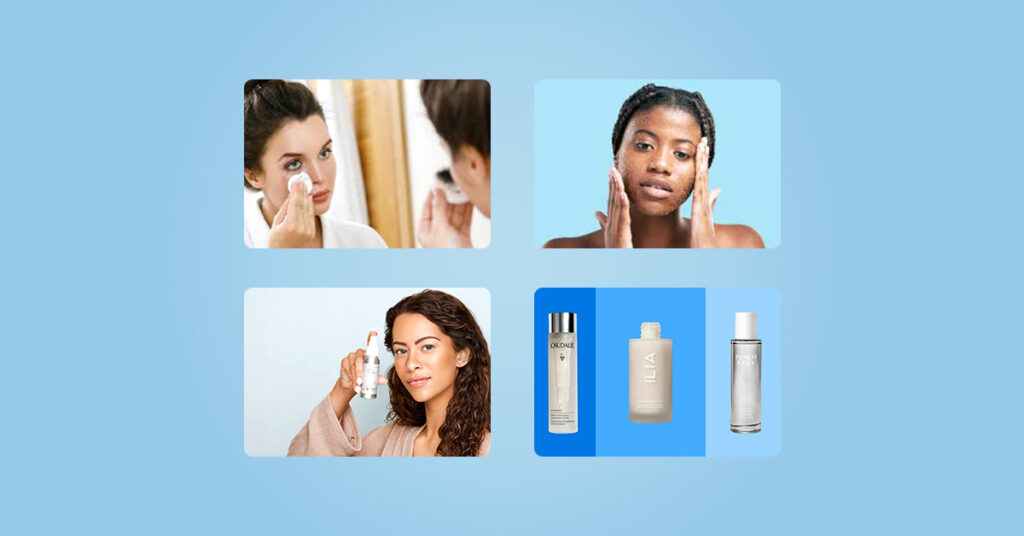
3. Toning: Restore pH Balance
Why it’s important: Toning in the evening, like in the morning, helps balance your skin’s pH and soothes any skin irritation.
Recommended Product: Klairs Supple Preparation Unscented Toner is gentle and hydrating, perfect for nighttime use.
4. Essence: Deep Hydration
Why it’s important: At night, your skin is more receptive to hydration and repair. An essence helps to boost hydration and prepares your skin for the next steps.
Recommended Product: The Hada Labo Gokujyun Hyaluronic Acid Lotion is a great choice for intense hydration.
5. Treatments: Target Specific Concerns
Why it’s important: Treatments like serums or ampoules are packed with high quality concentrations of active ingredients to address specific concerns such as acne, hyperpigmentation, or wrinkles.
Recommended Product: For acne, the COSRX Acne Pimple Master Patch is effective. For brightening, consider the Klairs Freshly Juiced Vitamin C Serum.
6. Eye Cream: Hydrate and Protect
Why it’s important: The delicate skin around your eyes requires special care to prevent fine lines and dark spots or circles.
Recommended Product: The Mizon Snail mucin Repair Eye Creams is renowned for its hydrating and repairing properties.
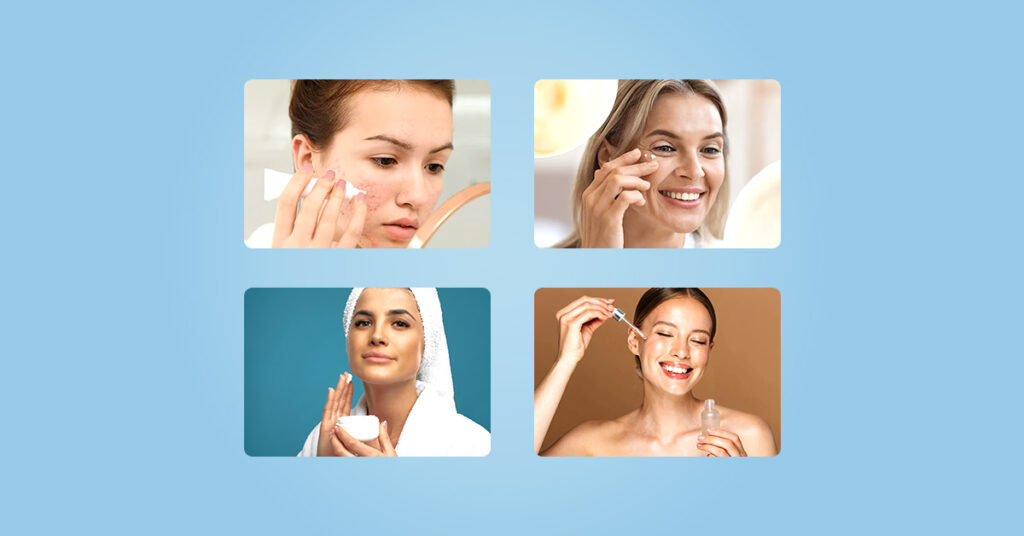
7. Moisturizing: Nourish and Repair
Why it’s important: Night creams are typically richer than day creams, providing essential nutrients and hydration to repair and rejuvenate your skin overnight.
Recommended Product: The Laneige Water Sleeping Mask or the Innisfree Night Cream with Green Tea Seed Oil binds the dirt are excellent choices for overnight hydration.
8. Facial Oils: Seal in Moisture
Why it’s important: Facial oils provide an additional layer of moisture, sealing in all the previous steps and enhancing skin barrier function.
Recommended Product: The Ordinary 100% Organic Cold-Pressed RoseHip Seed Oil is great for brightening and repairing skin.
Get a Customized Skincare Routine With Our Experts
Are you looking for a korean skin care routine order just for you? Our experts are here to help! With our personalized skin care consultation, you will receive a program tailored to meet your unique skin needs and goals.
Whether you want to address specific concerns such as acne, dryness, or signs of aging, our team will evaluate your skin and recommend the best products and steps for you.
Don’t settle for a generic skincare routine, get one that’s customized just for you. Contact Dr.Hanan skin care specialist today to get started on your path to glowing, healthy skin!
Conclusion
Implementing a south Korean skincare routine can transform your skin’s health and appearance. By following these morning and night beauty routines, you can enjoy the benefits of hydrated, glowing skin. Remember, consistency is key, and it’s essential to choose products that suit your skin types and concerns.
FAQs
It is advisable to wait 1-2 minutes between each step for the product to fully absorb.
Although some steps are optional, it is generally recommended that you follow a routine for best results. Skipping steps will cut down on your skincare routine.
Exfoliate 2-3 times per week depending on skin sensitivity and type of exfoliant used.
Some products, such as cleansers and toners, can be used morning and night. However, overnight treatments and overnight skin care treatments are often different.
If you develop allergic reactions, stop using the product and consult a dermatologist. It also helps to patch test new features before adding them to your system.
Table of Contents
How to Stop Hair Loss: Treatments & Natural Remedies
In this guide, we look at the best ways to stop hair loss immediately with help from science and experts.
Hair Transplant Pain: What Should You Expect?
Hair Transplant Pain: What Should You Expect?
Hair transplant pain is minimal with modern techniques. Learn what to expect during and after the procedure at Dr. Hanan Clinic.
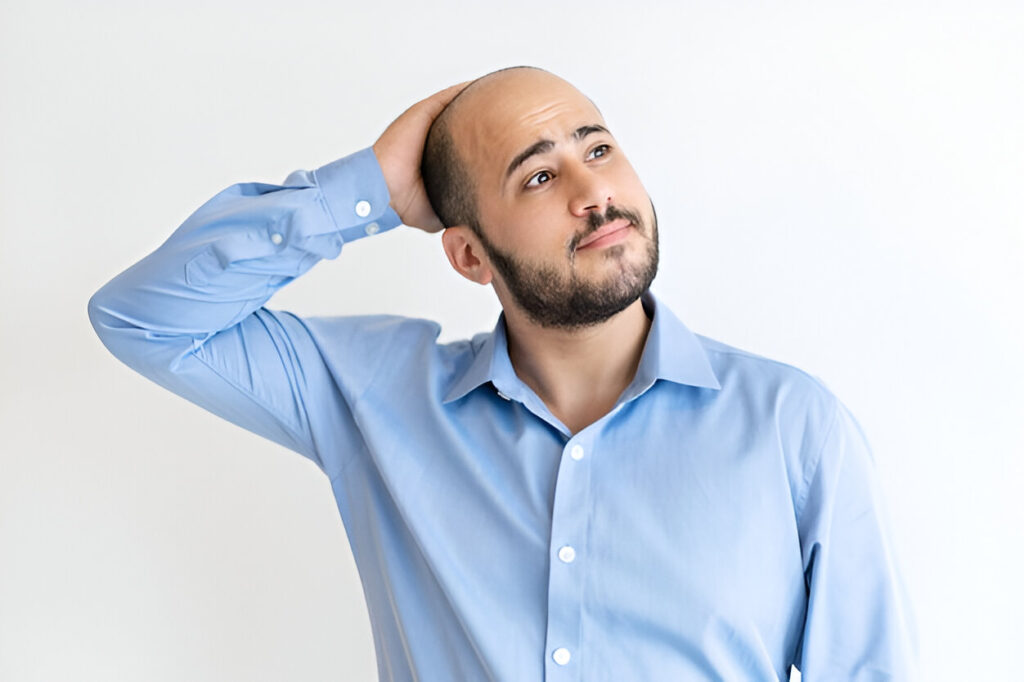
One of the most common worries among people considering hair transplantation is pain. Small incisions and hair follicles can be thought of being extracted or implanted. If you are thinking how painful a hair transplant is really, you are not alone. At Dr. Hanan Dermatology Specialty and Trichology Clinic, we asked this question in almost every consultation. In this blog, we will explain what you can really expect in terms of both hair transplant pain during and later, and why it is more manageable than most people think.
Is a Hair Transplant Painful?
Hair transplant procedures, particularly modern techniques like FUE (Follicular Unit Extraction) and FUT (Follicular Unit Transplantation), are minimally invasive and designed to ensure maximum comfort. Contrary to common fears, hair transplants are not painful, especially when performed by experienced dermatologists using advanced tools and anesthetics.
What Happens During the Procedure?
The process begins with local anesthesia so that both the donor and recipient of the scalp can be numb. Most patients described the injection of the anesthetic as a brief pinch or stinging sensation. Once the anesthesia becomes effective, the scalp becomes completely numb, and you do not feel any pain during the extraction or implantation process. More and more, patients report a mild sensation of pressure or movement, but nothing is sharp or uncomfortable.
During a FUE process, an individual follicle is extracted from the donor area using a small punch tool. Thanks to anesthesia, this process is painless. Similarly, when the graft is transplanted into thin or bald areas, the experience is free from pain. In a FUT procedure, where a strip of skin is removed from the back of the scalp, initial discomfort is still controlled with anesthesia, and the process of stitching is complete without you feeling anything.
How Painful Is the Recovery Period?
After the procedure, anesthesia gradually stops, and you may experience some mild soreness, tightness or feeling of pressure in treated areas. However, this discomfort is usually light and manageable. Most patients describe it as less intense than regular headaches. Over-the-counter or prescribed painkillers are usually sufficient to relieve any post-operative discomfort. At Dr. Hanan Clinic, we provide post-procedure care kits that include pain management medication, soothing spray and instructions that you heal comfortably.
What Does the Healing Process Feel Like?
The healing process is also relatively easy. In the first few days, you can see minor redness, nap, or itching in the transplant area. These symptoms are not painful, but may be a bit annoying. It is important not to scratch or disturb the region as it heals. Within a week to ten days, the most visible signs of the procedure fades, and the discomfort decreases significantly or disappears.
Does Everyone Experience the Same Level of Pain?
An important thing to understand about hair transplant pain is that it varies a bit from person to person. Some people have more pain limit, while others may be more sensitive. However, modern hair transplant techniques are carefully designed to prefer patient comfort. At our Clinic, we also offer additional comfort measures such as numbing sprays, cooling fans and even calming music or entertainment during long sessions.
What Do Patients Say About the Pain?
If you are still worried about the pain, it can help listen to those who have already undergone the process. Most of our patients are surprised by how smooth and comfortable the process is. In fact, many people say that they spend the process of watching movies, browsing their phones or even naps. It is far from the painful operation he had imagined.
Will the Pain Return After a Few Days?
Another common anxiety is the recovery phase. Patients often ask whether the scalp will hurt days or weeks after transplantation. The truth is, if you follow the proper aftercare instructions, the pain quickly fades and doesn’t come back. At Dr. Hanan Clinic, our dermatologists make sure that your scalp remains healthy and taken care of through scheduled follow -ups.
Final Verdict: Is Hair Transplant Pain Worth It?
In summary, if you are putting off a hair transplant because you are afraid of pain, know that today’s procedures are surprisingly gentle.
Thanks to Local anesthesia, advanced technology and specialist care, the pain levels involved are very low – often comparable to minor dental procedures. Brief, mild discomfort is a small price to pay for the long -term benefits of natural, permanent hair restoration.
Therefore, if you are searching online about hair transplant pain, then be sure that reality is far more comfortable than myths. Consult our experts at Dr. Hanan Dermatology Specialty and Trichology Clinic in Chennai to understand your options and experience an almost painless journey for fuller, thicker hair.
Book Your Consultation Today!
Table of Contents
How to Choose the Right Sunscreen for Chennai’s Hot and Humid Climate
How to Choose the Right Sunscreen for Chennai’s Hot and Humid Climate
Choosing the right sunscreen in Chennai’s hot, humid climate is key. Learn how SPF, broad-spectrum, and lightweight formulas protect your skin from sun damage with Dr. Hanan Clinic experts.

Living in Chennai means enjoying plenty of sunshine, but it also comes with the challenge of protecting your skin from intense UV rays, high humidity, and year-round heat. Sunscreen is one of the most powerful tools in preventing sun damage, pigmentation, premature aging, and skin cancer. Yet, many people struggle to find the right sunscreen that works for Chennai’s tropical weather—where sweating, oiliness, and stickiness are constant concerns.
At Dr. Hanan Dermatology Speciality and Trichology Clinic in Chennai, we regularly help patients choose sunscreens that are not only effective but also comfortable for daily use in hot and humid conditions. This blog will guide you on everything you need to know before buying your next sunscreen.
Why Sunscreen Matters in Chennai’s Climate
Chennai is one of the hottest metropolitan cities in India, with high UV index levels throughout the year. UV rays penetrate deeply into the skin, causing:
- Pigmentation & tanning
- Melasma and dark spots
- Premature wrinkles & sagging
- Increased risk of skin cancer
Humidity worsens the issue by making traditional sunscreens feel greasy or heavy. That’s why choosing the right formulation is crucial for Chennai’s weather.
Key Factors to Consider When Choosing Sunscreen in Chennai
Go for Broad-Spectrum Protection
In Chennai, where the sun shines intensely almost year-round, it’s not enough to just look at the SPF number on your sunscreen. What really matters is broad-spectrum protection. This ensures your sunscreen shields you from both UVA rays, which penetrate deeply and cause premature aging, melasma, and hyperpigmentation, and UVB rays, which damage the outer layer of skin, causing sunburns and increasing the risk of skin cancer.
Many patients visiting Dr. Hanan Clinic in Chennai struggle with stubborn pigmentation and tanning simply because they were using sunscreens that only protected against UVB. Look for labels like PA+++ or PA++++ (which indicate stronger UVA protection) along with SPF 30 or higher. This combination offers the safest and most reliable coverage in our tropical climate.
Pick the Right SPF for Chennai’s Sun
The SPF (Sun Protection Factor) tells you how well your sunscreen protects against UVB rays. In Chennai, where the UV index often stays at high or extreme levels, using a stronger SPF is crucial.
- SPF 30: Protects against about 97% of UVB rays. It’s enough if you spend most of your day indoors, commuting short distances, or working in air-conditioned offices.
- SPF 50 or higher: Blocks 98–99% of UVB rays, which makes it ideal for outdoor workers, athletes, beach-goers, and anyone exposed to sunlight for extended hours.
Dermatologists recommend SPF 50 as a safe standard in Chennai because it balances maximum protection with daily comfort. Remember, no SPF can block 100% of UV rays, which is why reapplication is just as important as SPF strength.
Hydrate Without Grease
One of the biggest complaints we hear at Dr. Hanan Dermatology Clinic is, “Sunscreens feel too sticky in Chennai’s weather.” The high humidity increases sweating, which makes heavy creams uncomfortable and often leads to clogged pores, acne breakouts, and greasy skin.
That’s why we recommend:
- Gel-based sunscreens → Perfect for oily and acne-prone skin, lightweight, and refreshing.
- Water-based sunscreens → Absorb quickly and don’t leave a white cast.
- Matte-finish sunscreens → Control excess oil and shine, great for those with seborrheic skin.
Look for sunscreens labeled non-comedogenic, oil-free, or mattifying. These prevent blocked pores and acne flare-ups while still giving strong UV protection. Patients who switched to these formulations often say they finally feel comfortable wearing sunscreen daily.
Consider Your Skin Type
Choosing sunscreen is not one-size-fits-all—it should be based on your unique skin type.
- Oily/Acne-Prone Skin: Go for gel or fluid sunscreens with ingredients like niacinamide, zinc oxide, or silica, which help control sebum while protecting the skin.
- Dry Skin: Cream or lotion-based sunscreens with hyaluronic acid, ceramides, or glycerin lock in moisture and prevent the skin from drying out in air-conditioned environments.
- Sensitive Skin: Use mineral sunscreens with titanium dioxide or zinc oxide. They sit on top of the skin and deflect UV rays instead of absorbing them, making them gentler and less irritating.
At Dr. Hanan Clinic, our dermatologists first analyze your skin and lifestyle, then recommend sunscreens tailored to you—because the wrong sunscreen often worsens existing problems like acne, pigmentation, or sensitivity.
Sweat & Water Resistance is Key
In Chennai’s climate, sweat is unavoidable. Whether you’re commuting, exercising, or just stepping outside, your sunscreen can wear off quickly if it isn’t resistant.
Look for sunscreens labeled:
- “Water-resistant” (lasts 40 minutes in water/sweat)
- “Very water-resistant” (lasts up to 80 minutes)
These formulations are especially important for:
- Outdoor workers
- Swimmers and athletes
- People with naturally oily or sweaty skin
Even with water resistance, you still need to reapply, but these sunscreens provide added reliability for longer protection in Chennai’s humidity.
Reapply Every 2–3 Hours
A major misconception is that applying sunscreen once in the morning is enough. But in Chennai’s heat, sunscreen breaks down faster due to sweat, sebum, and sun exposure.
Dermatologists recommend:
- Reapplying every 2–3 hours when outdoors.
- Using powder or spray sunscreens for easy reapplication on top of makeup.
- Carrying a travel-size sunscreen for convenience.
Skipping reapplication is one of the top reasons patients still develop pigmentation and tanning even though they’re “using sunscreen daily.” Consistency and correct usage are just as important as the sunscreen brand itself.
Dermatologist-Recommended Ingredients to Look For
- Zinc oxide & titanium dioxide → Best for sensitive skin, provides physical UV barrier.
- Niacinamide → Controls oil and reduces pigmentation.
- Antioxidants (Vitamin C, E) → Provide extra protection from free radicals.
- Hyaluronic Acid → Keeps skin hydrated without greasiness.
Common Mistakes to Avoid
- Applying too little sunscreen (you need 2–3 fingers’ worth for face & neck).
- Skipping sunscreen on cloudy days (UV rays still penetrate).
- Using makeup with SPF alone (not enough coverage).
- Not reapplying every 2–3 hours.
Sunscreen Recommendations at Dr. Hanan Clinic
At Dr. Hanan Dermatology Speciality and Trichology Clinic in Chennai, we recommend sunscreens tailored to:
- Daily office wear – Lightweight, SPF 50, matte finish.
- Outdoor workers/athletes – Sweat-resistant, SPF 50+, gel-based.
- Sensitive/Acne-prone skin – Mineral-based, fragrance-free sunscreens.
We also integrate sunscreen into comprehensive skin care plans for pigmentation, acne scars, and anti-aging.
Sunscreen Recommendations at Dr. Hanan Clinic
At Dr. Hanan Dermatology Speciality and Trichology Clinic in Chennai, we recommend sunscreens tailored to:
- Daily office wear – Lightweight, SPF 50, matte finish.
- Outdoor workers/athletes – Sweat-resistant, SPF 50+, gel-based.
- Sensitive/Acne-prone skin – Mineral-based, fragrance-free sunscreens.
We also integrate sunscreen into comprehensive skin care plans for pigmentation, acne scars, and anti-aging.
Final Thoughts
Choosing the right sunscreen for Chennai’s hot and humid climate is not just about comfort—it’s about long-term skin protection. With the right sunscreen, you can prevent pigmentation, tanning, early aging, and serious skin damage while staying fresh and comfortable throughout the day.
At Dr. Hanan Clinic, Chennai, our dermatologists help patients find sunscreens and skin care plans perfectly suited for their lifestyle and skin type.
Frequently Asked Questions
No, oily skin is not harmful. In fact, it slows down visible aging. However, excess oil can cause acne, clogged pores, and pigmentation if not managed.
Oily skin cannot be “cured” as it is largely genetic and hormonal. But with proper skincare, lifestyle changes, and medical treatments, it can be effectively controlled.
Choose a lightweight, oil-free moisturizer with hyaluronic acid or niacinamide to balance hydration without clogging pores.
Book Your Consultation Today!
Table of Contents
Sun Damage on Indian Skin: Best Treatments and Prevention Tips
Sun Damage on Indian Skin: Best Treatments and Prevention Tips
Learn how sun damage affects Indian skin and explore dermatologist-approved treatments like peels, lasers & glutathione at Dr. Hanan Clinic, Chennai.
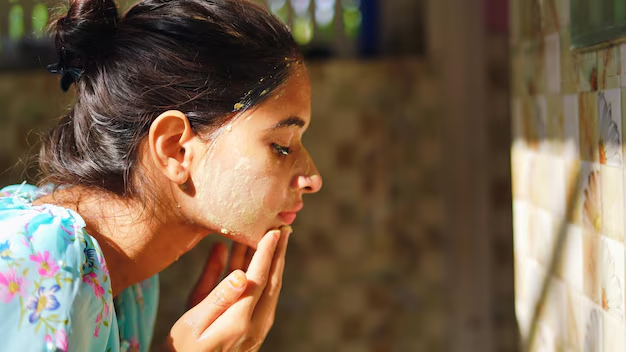
Living in Chennai means enjoying plenty of sunshine, but it also comes with the challenge of protecting your skin from intense UV rays, high humidity, and year-round heat. Sunscreen is one of the most powerful tools in preventing sun damage, pigmentation, premature aging, and skin cancer. Yet, many people struggle to find the right sunscreen that works for Chennai’s tropical weather—where sweating, oiliness, and stickiness are constant concerns.
At Dr. Hanan Dermatology Speciality and Trichology Clinic in Chennai, we regularly help patients choose sunscreens that are not only effective but also comfortable for daily use in hot and humid conditions. This blog will guide you on everything you need to know before buying your next sunscreen.
How Does Sun Damage Affect Indian Skin?
Indian skin falls mostly under Fitzpatrick skin types III to V, which means it tans easily but burns less frequently. While this provides some natural protection, it also results in hyperpigmentation, sunspots, and uneven skin tone.
Common signs of sun damage include:
- Dark patches and pigmentation (melasma, freckles)
- Premature wrinkles and fine lines
- Sun tan that doesn’t fade easily
- Rough, dry texture
- Loss of skin elasticity
- Increased risk of actinic keratosis (precancerous lesions)
Best Dermatologist-Approved Treatments for Sun Damage
Chemical Peels
Medical-grade chemical peels gently exfoliate the damaged skin layer, reducing sun tan, pigmentation, and dullness. Peels with glycolic acid, lactic acid, and TCA are highly effective for Indian skin when performed under expert supervision.
👉 Learn more about our Chemical Peel Treatments in Chennai
Laser Skin Resurfacing
Advanced lasers like Q-switched Nd:YAG and Fractional CO2 target pigmentation, sunspots, and fine lines. They work by stimulating collagen production and evening out skin tone. This is ideal for stubborn sun damage that doesn’t improve with creams or peels.
👉 Related: Laser Treatment for Scars
Hydrafacial and Medical Facials
Unlike salon facials, dermatologist-supervised Hydrafacials cleanse, exfoliate, and infuse the skin with antioxidants, leaving it hydrated and radiant. They are excellent for removing tan, pollution buildup, and early sun damage.
👉 Explore our Hydrafacial Treatments in Chennai.
Topical Dermatologist-Prescribed Creams
For stubborn pigmentation and dullness, IV Glutathione therapy combined with Vitamin C helps brighten skin from within by reducing melanin production and improving overall radiance.
Topical Dermatologist-Prescribed Creams
For stubborn pigmentation and dullness, IV Glutathione therapy combined with Vitamin C helps brighten skin from within by reducing melanin production and improving overall radiance.
Prevention Tips for Sun Damage
While treatments can reverse existing damage, prevention is key in Chennai’s tropical climate.
Apply Sunscreen Daily
Choose a broad-spectrum sunscreen SPF 50+ that protects against both UVA and UVB rays. Gel-based sunscreens are best for oily skin, while cream-based work for dry skin.
👉 Helpful read: How to Choose the Right Sunscreen for Chennai’s Hot and Humid Climate.
Wear Protective Clothing
Use hats, sunglasses, and long sleeves when outdoors. Opt for UPF-rated fabrics for added UV protection.
Avoid Peak Sun Hours
The sun’s rays are harshest between 10 AM – 4 PM. If possible, limit direct exposure during these hours.
Follow a Healthy Skincare Routine
- Cleanse your skin gently after outdoor exposure
- Use antioxidant serums at night
- Moisturize daily to repair barrier function
Stay Hydrated and Eat Smart
A diet rich in Vitamin C, Vitamin E, Omega-3 fatty acids, and antioxidants strengthens skin from within and helps fight oxidative damage caused by UV rays.
When to See a Dermatologist
If you notice:
- Persistent dark patches (melasma, pigmentation)
- Rough lesions or patches that don’t heal
- Premature wrinkles at a young age
- Uneven skin tone despite home care
…it’s time to consult a dermatologist. At Dr. Hanan Clinic, we provide personalized sun damage treatments in Chennai tailored to your skin type, ensuring long-lasting results.
Final Thoughts
Sun damage on Indian skin is common but preventable. With the right treatments like chemical peels, lasers, Hydrafacial, and glutathione therapy, combined with preventive steps like sunscreen and healthy habits, you can maintain youthful, radiant, and healthy skin.
At Dr. Hanan Dermatology Speciality and Trichology Clinic, our experts specialize in treating pigmentation, tanning, and sun-related skin concerns with advanced, safe, and proven solutions.
Book Your Consultation Today!
Table of Contents
Scalp Health Before Hair Transplant: Why Preparation Matters
Scalp Health Before Hair Transplant: Why Preparation Matters
Healthy scalp before hair transplant ensures lasting results. At Dr. Hanan Clinic, Chennai, treating scalp issues boosts graft survival and growth.”
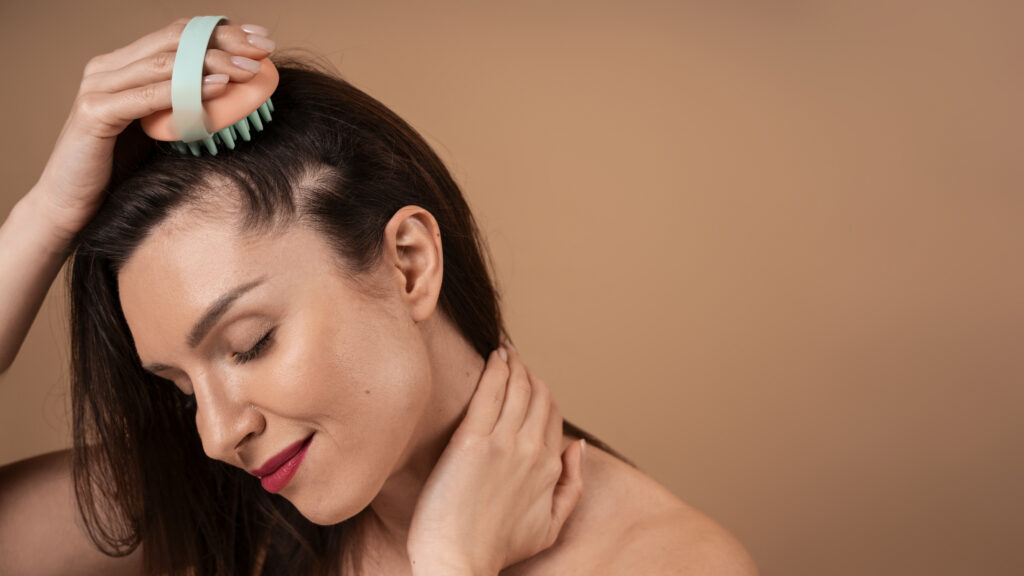
Hair transplantation has become one of the most effective and permanent solutions for baldness and thinning hair. However, what many patients don’t realize is that the success of a hair transplant depends heavily on the condition of the scalp before surgery. Preparing your scalp is not just a recommendation—it is a crucial step that influences graft survival, healing, and long-term results.
At Dr. Hanan Dermatology Speciality and Trichology Clinic, Chennai, we emphasize scalp health as the foundation for natural, lasting hair transplant outcomes. In this blog, our dermatologists explain why scalp preparation is important, what steps patients should take, and how to maximize transplant success.
Why Is Scalp Health Important Before a Hair Transplant?
Your scalp is the “soil” where transplanted hair grafts will grow. If the scalp is unhealthy—due to dandruff, infections, poor circulation, or inflammation—the newly transplanted follicles may not survive. A well-prepared scalp ensures:
- Stronger Graft Survival: Healthy scalp tissue provides proper blood supply and nutrients.
- Faster Healing: A clean, hydrated scalp recovers quicker with less post-surgical discomfort.
- Reduced Risk of Infection: Pre-treatment prevents scalp infections or folliculitis.
- Natural Results: A well-conditioned scalp ensures transplanted hair grows seamlessly with existing hair.
Patients often ask, “Does scalp condition really affect transplant success?” The answer is yes. Studies show that poor scalp health can lower graft survival rates by up to 20–30%.
Common Scalp Issues That Must Be Treated Before Transplant
Many patients in Chennai visit us with pre-existing scalp concerns. These must be addressed before the transplant procedure:
- Dandruff & Seborrheic Dermatitis – Flaky, itchy scalp increases inflammation.
- Scalp Infections – Bacterial or fungal infections can interfere with graft healing.
- Psoriasis & Eczema – Chronic skin conditions cause irritation and scarring.
- Oily & Congested Scalp – Excess sebum clogs pores and affects graft anchoring.
- Poor Circulation – Stress and lifestyle factors can reduce blood flow to hair follicles.
Our dermatologists treat these conditions in advance using medicated shampoos, antifungal therapies, and topical solutions before moving forward with surgery.
Steps to Prepare Your Scalp Before a Hair Transplant
Medical Consultation and Scalp Analysis
At Dr. Hanan Clinic, every patient undergoes trichoscopy and scalp analysis before planning surgery. This helps us identify dandruff, scalp infections, or poor skin barrier function. Based on the results, we customize a scalp preparation plan.
Use Dermatologist-Prescribed Shampoos
Patients are advised to use medicated shampoos containing:
- Ketoconazole (for dandruff and fungal issues)
- Zinc pyrithione (for oil control)
- Salicylic acid (for scalp exfoliation)
These shampoos reduce flakes, clean the pores, and create an ideal environment for transplant grafts.
Improve Blood Circulation
A healthy scalp requires good blood flow. We recommend:
- Scalp massage with dermatologist-approved oils to stimulate circulation.
- Low-Level Laser Therapy (LLLT) sessions for patients with poor scalp vascularity.
Lifestyle changes—regular exercise and stress management.
Avoid Smoking and Alcohol
Nicotine and alcohol reduce oxygen flow in the bloodstream, delaying wound healing. Patients must stop smoking and drinking at least 2 weeks before surgery to ensure better graft survival.
Treat Pre-Existing Conditions
If you have scalp psoriasis, eczema, or dermatitis, these must be treated first. At our clinic, we use topical steroids, anti-inflammatory serums, and oral medications when required. Transplantation is only scheduled once the scalp is stable
Maintain Scalp Hygiene
Simple hygiene measures matter:
- Wash hair regularly with mild shampoo.
- Avoid harsh styling products (gels, sprays).
- Do not scratch or pick at the scalp.
Nutrition for Scalp Health
Diet directly affects scalp condition. Patients are encouraged to include:
- Protein-rich foods (fish, eggs, legumes)
- Iron and zinc (green leafy vegetables, nuts)
- Omega-3 fatty acids (flaxseed, walnuts, salmon)
- Vitamin C and antioxidants (citrus fruits, berries)
Supplements may also be prescribed for patients with deficiencies.
Post-Preparation: What to Expect During Surgery
Once your scalp is ready, you’re fit for surgery. At Dr. Hanan Dermatology Speciality and Trichology Clinic, we use advanced methods like FUE (Follicular Unit Extraction) and FUT (Follicular Unit Transplantation). A healthy scalp allows:
- Faster healing of donor areas.
- Better anchoring of transplanted follicles.
- Reduced risk of complications.
Expert Advice from Dr. Hanan Clinic
Our dermatologists emphasize that a hair transplant isn’t just about surgery—it’s about preparation and aftercare. We guide patients at every step:
- Scalp health optimization before surgery.
- Customized aftercare plans.
Follow-up treatments like PRP therapy to boost graft survival.
For more insights, check out:
- Hair Transplant Aftercare Tips: Ensuring Long-Term Results
- Best Hair Transplant Clinic in Chennai
Final Thoughts
The success of your hair transplant doesn’t begin in the operation room—it begins weeks before, with proper scalp preparation. By treating dandruff, infections, and poor circulation in advance, you give your grafts the best possible chance to survive and thrive.
At Dr. Hanan Dermatology Speciality and Trichology Clinic, Chennai, our expert dermatologists ensure every patient is prepared, treated, and supported throughout the journey. Healthy scalp equals healthy results.
Book Your Consultation Today!
Table of Contents
How Many Grafts Do You Need for a Successful Hair Transplant?
How Many Grafts Do You Need for a Successful Hair Transplant?
Wondering how many grafts you need for a successful hair transplant? Learn graft requirements, costs, and expert insights
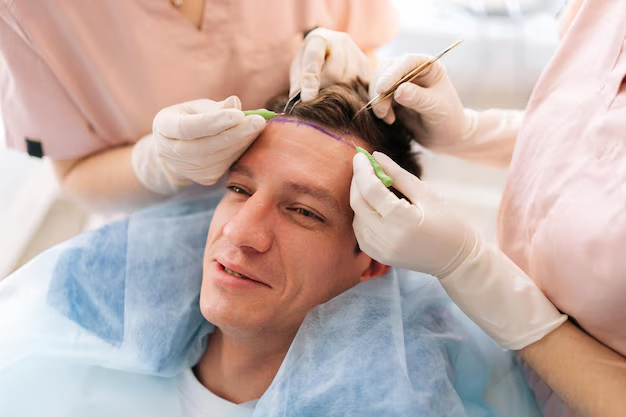
How Many Grafts Do You Need for a Successful Hair Transplant: Hair loss can be emotionally challenging, especially when it starts affecting your confidence and appearance. For many, a hair transplant in Chennai offers a permanent, natural-looking solution. But one of the most common questions patients ask is: “How many grafts do I actually need for a successful hair transplant?”
The answer isn’t one-size-fits-all. It depends on your stage of baldness, hair density goals, and the technique used. At Dr. Hanan Dermatology Speciality and Trichology Clinic, we provide personalized assessments to determine the exact number of grafts required for long-term, natural results.
What Are Hair Grafts?
A hair graft is a small piece of skin containing hair follicles. Each graft can contain anywhere from 1 to 4 hair follicles. During a hair transplant, these grafts are extracted from the donor area (usually the back or sides of the scalp) and implanted into thinning or balding areas.
The number of grafts you need directly determines:
- The density of your new hair
- The coverage area (front hairline, crown, or full scalp)
- The cost of the procedure
Factors That Decide How Many Grafts You Need
Stage of Baldness (Norwood Scale)
Dermatologists use the Norwood Scale to classify male pattern baldness.
- Early stages (Norwood 2–3): May need 800–1,500 grafts.
- Moderate baldness (Norwood 4–5): Around 2,000–3,000 grafts.
- Advanced baldness (Norwood 6–7): 3,500–5,000+ grafts may be required.
Desired Hair Density
Some patients want a fuller, denser look, while others are satisfied with moderate coverage. The higher the density goal, the more grafts are needed.
Donor Area Availability
Your donor area (the back and sides of the scalp) must have enough strong, healthy follicles to supply grafts. If the donor area is limited, we plan carefully to balance density and coverage
Hair Characteristics
- Thicker hair → Fewer grafts needed for coverage
- Curlier hair → Appears denser
- Straight, fine hair → Requires more grafts for the same effect
Hair Characteristics
- FUE (Follicular Unit Extraction): Individual grafts are extracted. Best for precision and minimal scarring.
- FUT (Follicular Unit Transplantation): A strip of skin is removed and divided into grafts. Suitable for higher graft numbers in a single session.
Average Grafts Required for Different Areas
- Hairline Restoration: 800–1,200 grafts
- Frontal Zone (forehead area): 1,500–2,000 grafts
- Crown Area (vertex): 1,000–2,500 grafts
- Full Head Coverage: 3,000–5,000+ grafts
Example: A patient with moderate baldness (Norwood 4) may need around 2,500 grafts to restore the hairline and crown area with natural density.
How Many Sessions Will You Need?
Depending on your graft requirement and donor supply:
- Low grafts (1,500 or less): Usually completed in one session.
- High grafts (3,500+): May require two sessions for best results.
At Dr. Hanan Clinic, our dermatologists assess the scalp, donor density, and hair goals before planning the session count.
Does More Grafts Always Mean Better Results?
Not necessarily. While more grafts may give higher density, quality and placement matter more than quantity. Poorly placed or low-survival grafts won’t give natural results, no matter how many are implanted.
That’s why it’s essential to choose an experienced clinic with advanced technology. At Dr. Hanan Dermatology Speciality and Trichology Clinic, we use FDA-approved tools and follow strict protocols to ensure graft survival and natural outcomes.
Cost of Hair Transplant by Graft Count in Chennai
The cost of hair transplant in Chennai is usually calculated per graft:
- ₹30–₹45 per graft (depending on technique and clinic expertise).
So, a 2,000-graft transplant may cost around ₹60,000–₹90,000, while a 4,000-graft transplant could cost ₹1.2–₹1.6 lakhs.
Investing in the right number of grafts ensures not just coverage, but a natural hairline and lasting results.
Final Thoughts
The number of grafts you need for a successful hair transplant depends on baldness level, donor area, and personal goals. More grafts don’t always equal better results – skilled placement, advanced technology, and aftercare matter the most.
At Dr. Hanan Dermatology Speciality and Trichology Clinic, we take a personalized approach, ensuring every graft counts toward natural, lasting hair restoration.
Book Your Consultation Today!
Table of Contents
How to Find the Best Face Wash for Glowing Skin
How to Find the Best Face Wash for Glowing Skin
Find the best face wash for glowing skin based on your type. Chennai dermatologists at Dr. Hanan Clinic share expert tips and ingredients for radiant, healthy skin.

Table of Contents
Finding the best face wash for glowing skin isn’t just about picking the most popular product on the shelf. With so many cleansers – foaming, gel, cream, and exfoliating – it’s easy to get lost in the marketing. But your skin’s glow depends not on trends, but on science and skin type.
At Dr. Hanan Dermatology Speciality and Trichology Clinic, Chennai, our dermatologists guide patients daily on how to build an effective cleansing routine for radiant, healthy skin. Whether you have oily, dry, or sensitive skin, using the right dermatologist-recommended face wash can make a remarkable difference.
Why Choosing the Right Face Wash Matters
A face wash is more than a cleansing step — it’s the foundation of your glowing skin routine. Using the wrong type can strip your skin of its natural oils, trigger breakouts, or dull your complexion.
Your skin’s pH balance, hydration, and barrier integrity all depend on how you cleanse it. That’s why dermatologists at Dr. Hanan Clinic Chennai recommend using cleansers with gentle surfactants, hydrating ingredients, and antioxidants suited for your skin type.
A dermatologist-recommended face wash doesn’t just remove dirt and makeup — it supports your skin’s microbiome, regulates oil, and prepares your skin to absorb nutrients from serums and moisturizers.
1. Identify Your Skin Type Before Choosing a Face Wash
The first step in finding the best face wash for glowing skin is identifying your skin type. Here’s what dermatologists recommend:
Oily or Acne-Prone Skin
If you have oily skin, your face tends to feel greasy and shiny within hours of cleansing. The key is to balance oil production without over-drying. Choose a gel-based face wash for oily skin with:
- Salicylic Acid – unclogs pores and reduces acne.
- Niacinamide – regulates oil and brightens dull skin.
- Tea Tree Extract – antibacterial and calming.
These cleansers are lightweight, refreshing, and keep your pores clear in Chennai’s humid weather.
Dry Skin
For dry, flaky skin, avoid harsh foaming cleansers. Instead, go for cream-based or hydrating face washes enriched with:
- Hyaluronic Acid – locks in moisture.
- Ceramides – repair the skin barrier.
- Aloe Vera or Vitamin E – soothe and nourish.
A gentle cleanser ensures your skin feels supple and smooth instead of tight after washing.
Combination Skin
If your T-zone is oily and cheeks are dry, you have combination skin. The best option is a pH-balanced, non-stripping face wash with mild surfactants and hydrating ingredients.
Sensitive Skin
Choose a fragrance-free, sulfate-free cleanser with ingredients like Centella Asiatica or Panthenol. Avoid scrubbing or exfoliating cleansers that can irritate your skin barrier.
Dermatologist Tip: Avoid using bar soaps or alcohol-based cleansers — they can disrupt your skin’s microbiome and lead to dryness or breakouts.
Ingredients That Help You Achieve Glowing Skin
To achieve luminous, healthy skin, focus on face washes that brighten and hydrate, rather than those that promise “instant glow” with harsh chemicals.
Here are dermatologist-approved ingredients that actually work:
- Vitamin C – Brightens skin tone and reduces dullness.
- Lactic Acid & Glycolic Acid – Gently exfoliate dead skin cells for renewed glow.
- Niacinamide – Balances oil and improves texture.
- Green Tea Extract – Protects against pollution and inflammation.
- Licorice Root Extract – Reduces pigmentation and evens tone.
Pro Tip from Dr. Hanan Clinic: Avoid alcohol, parabens, and artificial fragrances that can cause irritation – especially in Chennai’s hot and humid weather.
Morning vs. Night Cleansing Routine
A proper cleansing routine plays a vital role in achieving glowing skin.
Morning Routine:
Start your day with a mild brightening cleanser to remove overnight oil and prepare your skin for sunscreen and makeup. If your skin is oily, use a gel-based cleanser with niacinamide or tea tree extract.
Night Routine:
Cleansing at night is non-negotiable — it removes dirt, oil, sweat, and pollutants accumulated throughout the day. Dermatologists recommend double cleansing:
- Use an oil-based cleanser to dissolve makeup or sunscreen.
- Follow up with a gentle foaming cleanser to deep clean pores.
- Check our detailed guide on Oily Skincare in Chennai to understand night care better.
Common Face Wash Mistakes to Avoid
Even the best cleanser can fail if used incorrectly. Here are red flags our dermatologists often see:
- Over-cleansing: Washing more than twice a day strips natural oils.
- Using hot water: It damages the skin barrier and causes redness.
- Skipping moisturizer: Cleansing without rehydrating can make skin feel tight.
- Using facial scrubs daily: Over-exfoliation leads to irritation and breakouts.
Green Flag: Use lukewarm water and follow every cleanse with a hydrating serum or moisturizer to lock in moisture.
Read our full post on 10 Skincare Mistakes You Don’t Know You’re Making.
Dermatologist-Approved Face Wash Routine for Glowing Skin
- Wet your face with lukewarm water.
- Massage the cleanser gently in circular motions for 30–40 seconds.
- Rinse thoroughly and pat dry with a soft towel — never rub harshly.
- Follow with a toner, Vitamin C serum, and a moisturizer.
- Finish with sunscreen in the morning or hydrating cream at night.
At Dr. Hanan Clinic, we often combine at-home skincare with advanced Hydrafacial or Medi-Fusion Glow Therapy treatments for long-lasting glow and hydration.
Face Wash Recommendations by Skin Type (From Chennai Dermatologists)
Skin Type | Recommended Type | Key Ingredients |
Oily / Acne-Prone | Gel-based foaming cleanser | Salicylic acid, tea tree, niacinamide |
Dry | Cream-based or hydrating | Hyaluronic acid, ceramides, aloe vera |
Combination | Gentle pH-balanced | Green tea, Vitamin E |
Sensitive | Fragrance-free & mild | Centella Asiatica, panthenol |
Dermatologist Note: At Dr. Hanan Dermatology Clinic, we perform a detailed skin analysis before suggesting any cleanser — because what works for one person may not work for another.
Expert Advice from Dr. Hanan Clinic, Chennai
At Dr. Hanan Dermatology Speciality and Trichology Clinic, we go beyond over-the-counter recommendations. Our dermatologists customize skincare plans for:
- Acne-prone and sensitive skin
- Dullness and pigmentation
- Post-treatment skin recovery
We offer medical-grade facial cleansers and in-clinic skin rejuvenation therapies like:
- Hydrafacial for instant glow
- Chemical peels for exfoliation
- Laser skin rejuvenation for deeper brightness
Each plan is designed based on your skin condition, weather, and daily exposure in Chennai.
Final Thoughts
The best face wash for glowing skin isn’t about expensive products — it’s about balance, consistency, and professional advice. A dermatologist-approved face wash gently removes impurities while maintaining hydration and radiance.
If you’re unsure which cleanser suits your skin, consult our dermatologists at Dr. Hanan Clinic Chennai for a personalized skincare plan that ensures your glow is here to stay.

